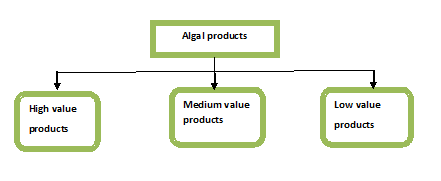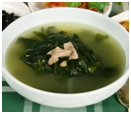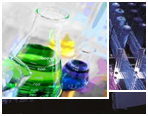Algae - Important Products and Applications
Introduction
Algae as a feedstock have been used for many products and applications, and new ones are constantly being discovered. With the recent surge in interest to use algae as a feedstock for biofuels, there is growing interest in utilizing the Algal Biomass in an optimal manner – not just to produce fuel but also valorizing the co-products of the process. Such an optimal utilization could make algae based biofuels more economically viable.
Valorization of co-products is an attractive option, given the fact that the world has the experience of using algae for a wide array of products. In addition to oil and Biodiesel the starch component of the biomass makes a suitable feedstock for the production of ethanol. The residue that is left over could then be used for conventional animal, fish or poultry feed, or for other nutraceuticals. There are emerging technologies using which the residue could be used to make products such as bioplastics.
The number of products that can be made from algae is virtually unlimited, due to the large variety of species (possibly in the millions) whose composition can be influenced by changing the cultivation conditions. With only a few commercial algae-based products available, this resource is largely untapped. This page at Oilgae attempts to bring out all the possible applications of algae and its market potential.
Algae Products Market
The market size of products from micro-algae was estimated by Pulz and Gross (2004) to have a retail value of US$ 5 – 6.5 billion.
|
Another study mentions a production of 10,000 T per year, almost all of it grown in open ponds, and mainly for use as nutritional supplements (van Harmelen and Oonk 2006).
The world market of products from macro-algae has been estimated to have a size of some US$ 5.5 - 6 billion per year (McHugh 2003; Pulz and Gross 2004).
- US$ 5 billion is generated by the food industry, of which US$ 1 billion is from “nori”, a high-value product worth US$ 16,000 / T
- US$ 600 million was generated by hydrocolloids (55,000 T) extracted from cell walls of macroalgae
Based on their market values, algal products are broadly classified into three types

|
Click to Know More |
|
|
Poly unsaturated fatty acids(DHA,ARA,GAL and EPA) Aquaculture Feed (Shrimp feed, Shellfish Feed, Marine Fish Larve cultivation ) |
|
Algae - Human Food
 Algae have been collected for more than 4000 years in China and Japan for use as human food. Today Japan is the principal user of edible algae, and the Japanese have developed methods for culturing and harvesting "leafy" algae. Large-scale farming practices are used to grow the red alga Porphyra, which is commonly called nori. Profitable products can be extracted from algae.
Algae have been collected for more than 4000 years in China and Japan for use as human food. Today Japan is the principal user of edible algae, and the Japanese have developed methods for culturing and harvesting "leafy" algae. Large-scale farming practices are used to grow the red alga Porphyra, which is commonly called nori. Profitable products can be extracted from algae.
There are many algae that are cultivated for their nutritional value, either for supplemental use, or as a food source.
Related Product Links: Agar, alginates and carrageenans
Possible Applications:
- Macroalgae as food source (Nori or purple laver, Aonori or green laver , Kombu or haidai,Wakame, quandai-cai, Hiziki , Mozuku, Sea grapes or green caviar, Dulse, Irish moss or carrageenan moss, Winged kelp, Ogo, ogonori or sea moss)
- Puddings, Sauces and Creams, Beverage/Juice, Sweet biscuits, Chocolates, Dark colored baked products, Edible coatings, Food colouring agents, Cheeses and butter or margarines, Food gels, Stabilizer/emulsifier, Food Packaging, Gelling and Thickening Agents
Pharmaceuticals & Health Related Products

Use of algae, especially the cyanobacteria (blue-green algae), for antibiotics and pharmacologically active compounds has received ever increasing interest. There are a range of pharmaceutical products derived from algae. Some of them include: antimicrobials, antivirals & antifungals, neuroprotective products, therapeutic proteins and drugs
Related Product Links: Algae in Pharmaceuticals, Omega-3 Fatty Acids, DHA, EPA, Astaxanthin, Beta Carotene
Possible Applications:
- Osmoregulators, Antioxidants, Anti-microbial agents (antibacterial, antifungal, antiprotozoa), Anti-tumor agents, Anti-obesity and anti-diabetic agents, Anti viral agents, Anti-inflammatory agents, Anti-adhesive therapies
- Aiding the immune, cardiovascular and nervous systems. Used in fibromyalgia, diabetes, and hypertension patients and in degenerative diseases treatment, skin disease treatment
- As a Fluorescent Pigment (Immunoassays), Therapeutic delivering agents, Radioactive protection
Other useful substances used for medicinal purposes include sterols, toxins, proteins, amino acids, MAA etc.
 Algae in Nutraceuticals:
Algae in Nutraceuticals:
Related Product Links: Spirulina, Chlorella, Poly unsaturated fatty acids(DHA,ARA,GAL and EPA), Beta carotene, Astaxanthin
Animal & Fish Feed
 Aquaculture - Micro-algae are an essential food source in the rearing of all stages of marine bivalve molluscs (clams, oysters, and scallops), the larval stages of some marine gastropods (abalone, conch), larvae of several marine fish species and penaeid shrimp, and zooplankton.
Aquaculture - Micro-algae are an essential food source in the rearing of all stages of marine bivalve molluscs (clams, oysters, and scallops), the larval stages of some marine gastropods (abalone, conch), larvae of several marine fish species and penaeid shrimp, and zooplankton.
Microalgae are used as essential live feeds and supplements in the aquaculture of larval and juvenile animals including oyster spat, juvenile abalone, finfish larvae and rotifer.
Related Product Links: Aquaculture Feed
Possible Applications: Cattle and hog feed, Pet food ingredient (aquarium food and speciality pet foods)
Algae in Cosmetics
In cosmetics, algae act as thickening agents, water-binding agents, and antioxidants. Carrageenans are extracted from red algae and alginates from the brown algae. Other forms of algae, such as Irish moss, contain proteins, vitamin A, sugar, starch, vitamin B1, iron, sodium, phosphorus, magnesium, copper and calcium. These are all beneficial for skin, either as emollients or antioxidants.
 Related Product Links: Algae in Cosmetics, Carrageenan, Alginates
Related Product Links: Algae in Cosmetics, Carrageenan, Alginates
Possible Applications: Anti-cellulite, Skin care, sun protection and hair care, Tooth paste, Shaving cream, Lotions and creams, Antibacterial cream
Algae Chemicals
 Algae biomass from which oil has been extracted (called the algae cake or de-oiled algae meal) can be used as organic fertilizers in place of synthetic fertilizers.
Algae biomass from which oil has been extracted (called the algae cake or de-oiled algae meal) can be used as organic fertilizers in place of synthetic fertilizers.
Algae can also be used as a starting material for a variety of specialty chemicals and polymers. The natural pigments produced by algae can be used as an alternative to chemical dyes and coloring agents.
Related Product Links: Chlorophyll, Phycocyanin, Phycoerythrin, Fucoxanthin
Possible Applications: Defoamers, Inks, Algae based resins, Speciality chemicals production, Stable isotopically labeled compounds, Dyes and colourants, Polyhydroxy alkonates
Algae in Pollution Control
 Algae are currently used in many wastewater treatment facilities, reducing the need for more dangerous chemicals. Algae can be used to capture the runoff fertilizers that enter lakes and streams from nearby farms. Algae are used by some power plants to reduce CO2 emissions.
Algae are currently used in many wastewater treatment facilities, reducing the need for more dangerous chemicals. Algae can be used to capture the runoff fertilizers that enter lakes and streams from nearby farms. Algae are used by some power plants to reduce CO2 emissions.
Related Product Links: Algae in Waste Water Treatment, Algae for CO2 Capture
Possible Applications: Wastewater treatment and nutrient credits, Biofilters for fish pond effluents, Heavy metal biosorption, CO2 capture, Soil additives, conditioners and fertilizers
Algae Bioplastics:
Typically, long chain polymers, present in the algae lipids are used for making bioplastics.

